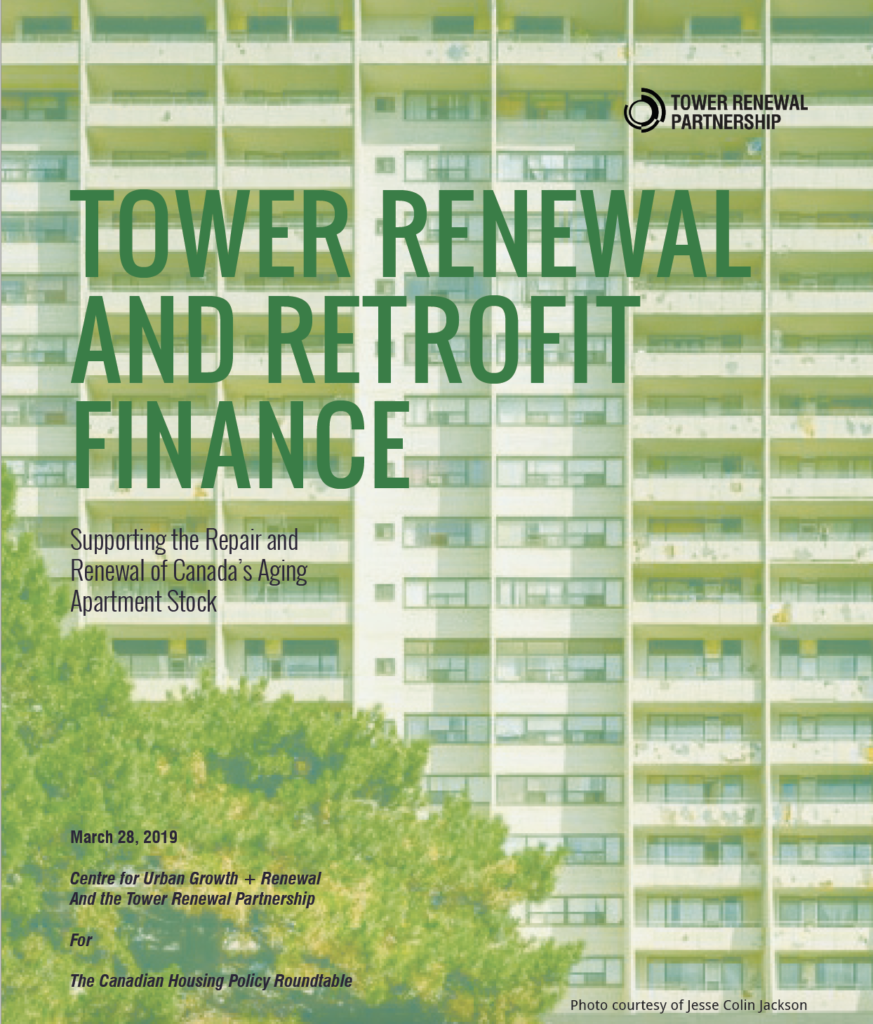In July, the Tower Renewal Partnership (“TRP”) released Tower Renewal and Retrofit Finance in support of the Canadian Mortgage and Housing Corporation’s interest in encouraging the retrofit and renewal of Canadian post-war towers. With much of Canada’s affordable purpose-built rental housing in need of renewal, the time to act is now. However, costs – along with the need to maintain affordability – continue to be a primary barrier.

As a result, the TRP has undertaken research uncovering the financial challenges and potential solutions. In 2017, the National Housing Collaborative and the TRP produced Financial Tools for Tower Renewal, which proposed program design considerations for the National Housing Strategy programs. Now with Tower Renewal and Retrofit Finance, the TRP has taken a deeper dive into the economics of comprehensive retrofits in apartment towers.
It is increasingly urgent that action be taken to avoid losing crucial housing to deterioration or loss of affordability.
Our research findings highlight the high costs of retrofits. Retrofits vary from core state of repair investments, upgrades to meet current health and safety standards, and a range of energy retrofits from modest to best in class. On top of energy retrofits, creating barrier-free accessible units is also very costly and has little Return On Investment (ROI). Further, buildings with substantive repair backlogs will require greater upfront investment for retrofits.
In many cases, the costs of retrofits is beyond the financial capacity of many owners. As a result, most buildings throughout Canada can not engage in retrofit without support. Further, economic motivations and financial capacity limits for-profit owners’ willingness to undertake deep retrofits. Owner capacity can vary significantly due to rent zones, vacancy rates and maintenance needs. Pre-existing debt will also significantly hinder an owner’s ability to raise money for retrofits. Some buildings have the financial capacity to engage in retrofit, while others do not. Additionally, the full use of a building’s finance capacity will be limited by for-profit owner’s seeking the best ROI for their investments. Retrofits typically do not generate returns commensurate with capital needs and project risks, particularly when not relying on rent increases.
Our research findings support the need for continued public investment. In many cases, substantial public investments are required to fully fund retrofits of post-war towers. In most scenarios tested during the study, a “financial gap” between the costs of retrofit and available funds, often substantial, exists in achieving renewal goals (including NHS public policy goals).
To bridge the “financial gap”, our analysis tested several tools that either expand existing financial capacity or limit the need to use the existing financial capacity of building owners:
- Expand financial capacity
- Lower-interest financing
- Limit need to use financial capacity
- Expand public grants
- Introduce an energy-backed loan product, that uses funds financed by long-term energy savings
- Introduce a “Repair and Renewal Mortgage Refinance” Tool that provides reduced interest rates and prolonged amortization rates
- Ensure all available tools have broad eligibility
In addition to these tools, our research found that considering additional programmatic changes and programs would increase the number of post-war towers undergoing retrofit and renewal work. These include:
- Develop a Portfolio Approach for building owners to access government support (such as NHS tools)
- Grow the Retrofit Industry with Demonstration Projects and Industry Support
- Empower Non-Profits to Acquire and Renew Private Housing Assets, as they are best positioned to meet public policy objectives and maintain affordability
- Consider changes to tax treatment, such as Capital Cost Allowances, in favour of retrofitting
- Provide Guidance for Renewal Standards as the approach to altering existing buildings varies significantly across provincial and territorial Building Codes
- Consider introducing regulation that would require retrofits for aging buildings.
Takeaways from this report:
- Many post-war towers that provide affordable homes for Canadians are in need of reinvestment.
- Retrofits are expensive and complex projects that are very different from new builds, including how they are financed.
- For-profit building owner’s financial capacity and motivations are at odds with investing in deep retrofits.
- The federal government has several options and levels of investment to consider further encouraging the renewal of this housing stock.
Download and read the full report here.